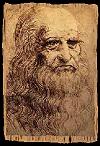|
Leonardo designed a large range of catapults, crossbows and slingshots. Though the newer artillery weapons were starting to take hold in his day, theses older weapons were still in wide-spread use. He took existing designs and worked to make them more efficient and easier to operate.
The rapid-firing crossbow was to be powered by an enormous treadmill and required a number of very strong men to pedal on steps placed around the rim of a wheel. To protect the walkers from attack, a large solid shield of wooden planks stood behind them. Four crossbows were attached to the machine and as it rotated an archer would discharge each bow. There was a braking system and a slot through which to view the enemy; it's possible that the wheel was halted during each firing so that the marksman could line up his target. The giant slingshot was tightened through the use of multiple springs, while his huge crossbow mounted on six wheels, and better-known as a ballista, was angled to absorb the force of the recoil. The work of drawing the seventy-six foot bow was carried out by a system of gears and it was released simply by striking a pin. Leonardo claimed his ballista to be silent in operation. This weapon was very advanced and may well have been beyond the building capabilities of the time. His quick-load catapult only had a short firing range, but this mattered little as guns then were slow loading and heavy. The catapult could be loaded quickly and, if necessary, left loaded in case of surprise attack. They did not need gun powder and could be safely mounted up on walls. With this catapult a man climbed the attached ladder, placed a stone in the cup, then the flexible arm was bent back using a rope and winder mechanism. This was released by striking a pin and the procedure repeated. Leonardo's plans also arranged very basic catapults in rows. These would be loaded and then launched simultaneously by a number of men striking them with large hammers. For his catapults Leonardo designed finned missiles with warheads. Similar to modern designs, it had two fins on the tail for stability. Upon impact strikers would ignite the gunpowder inside. |
|

